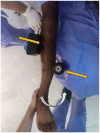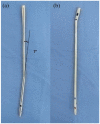Surgical management of tibia refracture with a bent intramedullary nail: A case report and review of the literature
- PMID: 38205142
- PMCID: PMC10777793
- DOI: 10.1177/2050313X231225338
Surgical management of tibia refracture with a bent intramedullary nail: A case report and review of the literature
Abstract
Intramedullary nailing is the gold standard for long bone fractures in the lower limbs. Fractures of the tibia with bending of the intramedullary nail is a very uncommon complication. Removing a bent nail is an unpredictable and challenging procedure for any trauma surgeon. We report the case of a 34-year-old man presenting a refractured tibia with a bent intramedullary nail following a motor vehicle accident. We describe the management of this patient as well as a substantial review of the literature to depict the peculiarities of this entity compared to its more commonly reported femoral counterpart. When approaching a deformed tibia nail, standard extraction techniques should be attempted and are more likely to be successful than in deformed femoral nails.
Keywords: Intramedullary nail; bent; case report; removal; review; tibia.
© The Author(s) 2024.
Conflict of interest statement
The authors declared no potential conflicts of interest with respect to the research, authorship, and/or publication of this article.
Figures





Similar articles
-
Removal of a bent tibial intramedullary nail: a rare case report and review of the literature.Chin J Traumatol. 2011 Apr 1;14(2):107-10. Chin J Traumatol. 2011. PMID: 21453578 Review.
-
Removing a bent femoral nail - man versus metal: A case report.Int J Surg Case Rep. 2022 Oct;99:107679. doi: 10.1016/j.ijscr.2022.107679. Epub 2022 Sep 19. Int J Surg Case Rep. 2022. PMID: 36181739 Free PMC article.
-
Removal of bent intramedullary nail: Two case reports.Medicine (Baltimore). 2020 May;99(20):e19935. doi: 10.1097/MD.0000000000019935. Medicine (Baltimore). 2020. PMID: 32443293 Free PMC article.
-
[Removal of a bent inflatable femoral nail: a case report].Acta Orthop Traumatol Turc. 2008 May-Jul;42(3):211-3. doi: 10.3944/aott.2008.211. Acta Orthop Traumatol Turc. 2008. PMID: 18716438 Turkish.
-
In Situ Straightening of a Bent Tibiofemoral Intramedullary Nail: Case Report and Review of the Literature.Iowa Orthop J. 2021;41(1):167-170. Iowa Orthop J. 2021. PMID: 34552420 Free PMC article. Review.
Cited by
-
Treatment of Infection After Tibial Intramedullary Nailing With Bone Distraction Combined With Free Anterolateral Thigh Flap for Concomitant Soft-tissue Defect.Plast Reconstr Surg Glob Open. 2024 Dec 13;12(12):e6346. doi: 10.1097/GOX.0000000000006346. eCollection 2024 Dec. Plast Reconstr Surg Glob Open. 2024. PMID: 39687414 Free PMC article.
References
-
- Meccariello L, Bisaccia M, Caraffa A, et al.. From the down to modern era: the history of the nailing. Can Open Orthop Traumatol J 2016; 3: 10–17.
-
- Yip KM, Leung KS. Treatment of deformed tibial intramedullary nail: report of two cases. J Orthop Trauma 1996; 10(8): 580–583. - PubMed
Publication types
LinkOut - more resources
Full Text Sources

